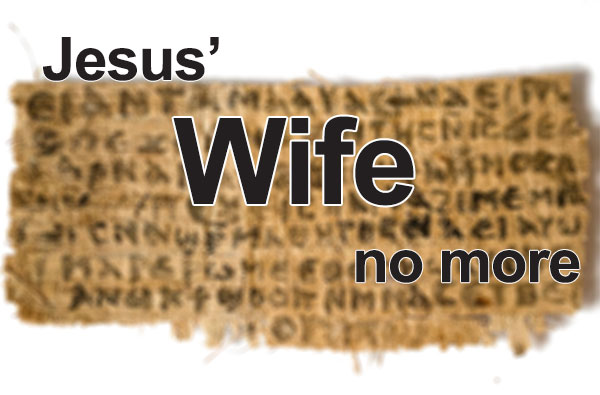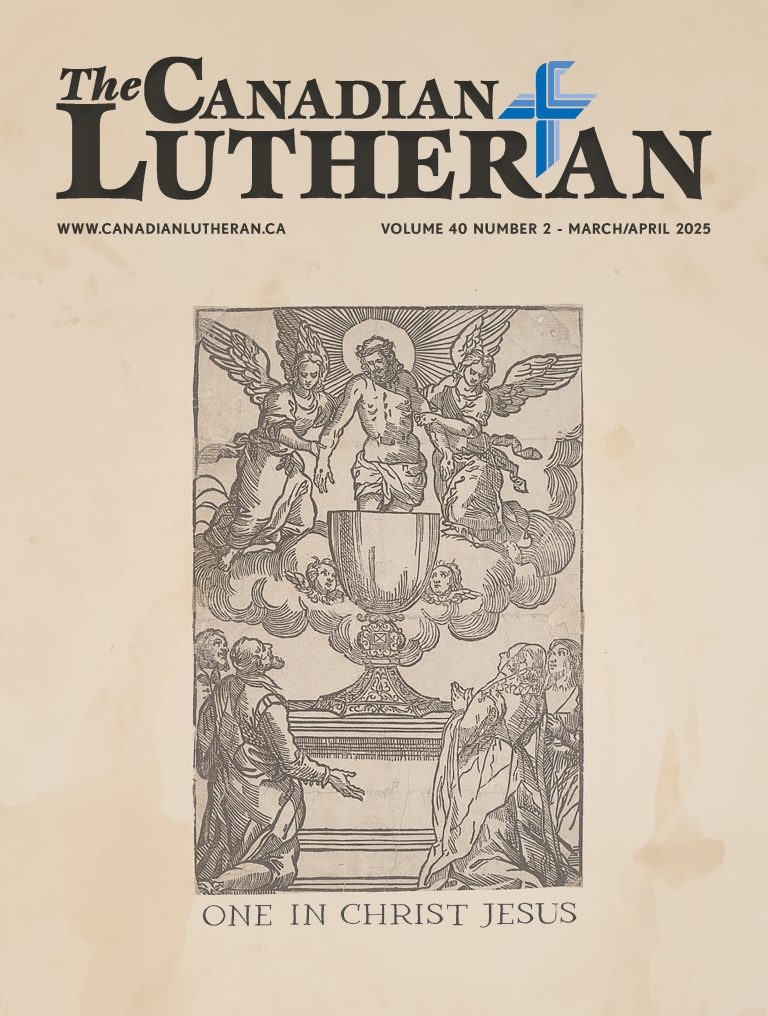Jesus’ ‘wife’ no more: New evidence suggests fragment a forgery

by Mathew Block
Back in 2012, Karen L. King, a scholar from Harvard Divinity School, announced the discovery of a Coptic manuscript fragment with some particularly surprising text. Among other things, it reads: “Jesus said to them, my wife…” And there the text breaks off. It’s not much, but it was enough to spark a media firestorm, with articles about The Gospel of Jesus’ Wife appearing in print and online all over the world.
It sounds like the plot of a best-selling thriller: scholars discover a lost manuscript which threatens to turn historic Christian teaching on its head. In fact, at least one best-selling novel—A Skeleton in God’s Closet by Paul L. Maier—followed a similar story. In Maier’s book, first published in 1993, an archaeological dig in Israel uncovers a skeleton which bears the marks of crucifixion. Add in a fragmentary manuscript which asserts the body to be that of Jesus Christ himself, and you’ll understand how the find rocks the faith of thousands around the world.
To be sure, the discovery of The Gospel of Jesus’ Wife fragment isn’t nearly so earth-shattering as Maier’s fictional story. As King herself admitted, the document doesn’t prove Jesus actually had a wife. The fragment, she suggested, was likely written in the fourth century. That’s hardly something to shake Christian teaching, media reports to the contrary notwithstanding.
Shortly after the announcement of the discovery, Maier—who, in addition to being a best-selling novelist, also served as the Russell H. Seibert Professor of Ancient History at Western Michigan University—said it was all much ado about nothing. At best, he explained, it’s just another document from early Christian heresies. “While the document is interesting, it is only another of the long string of Gnostic writings,” he wrote in an article for The Lutheran Church—Missouri Synod. “”Like all the others, it is of little or no use as authentic source material on Jesus. All Gnostic writings are late derivatives from the true Gospels and regularly offer information that runs counter to the mass of reliable evidence on Jesus.”
All Gnostic writings are late derivatives from the true Gospels and regularly offer information that runs counter to the mass of reliable evidence on Jesus.
The early Church faced a number of such heresies that attempted to co-opt Jesus for themselves. In fact, we can see St. Paul busy refuting what appears to be an early form of Gnostic heresy in his epistle to the Colossians. These heresies would flourish in the first few centuries after Jesus, and many of their writings have survived to this day. Perhaps The Gospel of Jesus’ Wife was just one another of these.
The Fraud
But there was always the possibility that this document was something more sinister than just late Gnostic heresy. Anyone who has read Maier’s A Skeleton in God’s Closet knows that the question of fraud must always be considered. And indeed, shortly after “The Gospel of Jesus’ Wife” was announced, other scholars were questioning its authenticity. Only a few days after the announcement was made, Francis Watson, a professor at Durham University, published a response online. His assessment of the manuscript is clear from the article’s title: “The Gospel of Jesus’ Wife: How a fake Gospel-Fragment was composed.”
Watson’s critique was devastating, demonstrating how the document was likely copied from a better known Gnostic text called The Gospel of Thomas. “The text has been constructed out of small pieces—words or phrases—culled from the Coptic Gospel of Thomas,” he writes. “This is most probably the compositional procedure of a modern author who is not a native speaker of Coptic.”
Watson goes on to demonstrate how each phrase was derived from Gnostic text, and even how the forger “slavishly follows” the line-division of the text he’s copying from. What is more, the fragment even seems to copy a typo from an online edition of The Gospel of Thomas. “This level of dependence on extent pieces of Coptic text is more plausibly attributed to a modern author, with limited facility in Coptic,” Watson concludes, “than to an ancient one.”
In light of the accusations of forgery, King held off on publishing her conclusions. The controversy then died down—until a few weeks ago, when the Harvard Theological Review finally published the results, including new tests which apparently confirmed the authenticity of the manuscript. Carbon dating suggested the papyrus was indeed very old, though not the fourth century origin King had suspected. The tests dated the manuscript to the eight century—a full four hundred years later than originally predicted. Likewise, the ink was found to have a similar chemical composition to that used by ancient Egyptians (though that, of course, doesn’t tell us when it was made or when it was applied to the papyrus).
But even these findings didn’t convince everyone: in the same issue of Harvard Theological Review, Brown University’s Leo Depuydt offered a response in which he argues that “the document is a forgery, and not a very good one at that.” His conclusion was the same as Watson’s: “The paramount truth, so far unrecognized, it seems, about the Text is that it is just about entirely a patchwork of words and phrases from the Gospel of Thomas…. This fact itself already sufficed for me to expose the text as a forgery…. An ancient native speaker of Coptic who could select and combine words and phrases from the Gospel of Thomas with understanding would possibly have produced [the text’s] grammatical errors.”
The document is a forgery, and not a very good one at that.
The papyrus might indeed be ancient, Depuydt and others argued, but the words written on it are not. Now, a few weeks later, new evidence that The Gospel of Jesus’ Wife is indeed a forgery has come to light. The manuscript in question had always been known to have been purchased along with other papyri. Analysis of one of these—a fragment of the Gospel of John—suggests it is an unquestionable forgery.
The New Evidence
At least that’s what Joel S. Baden and Candida R. Moss, professors at Yale Divinity School and the University of Notre Dame respectively, argue in a recent article for CNN. The fragment uses a rare dialect of Coptic, copying a known edition—available online—letter for letter, word for word, and line for line. What’s worse, the papyrus in question dates to at least a century after the Coptic dialect in question died out. “Whoever created this new Gospel of John fragment simply copied the beginning of every other line from the online version,” Baden and Moss write.
The problem for The Gospel of Wife manuscript is that the handwriting in the John fragment and the wife fragment appear to be the same. “Multiple experts agree that the fragment of John and Jesus’ wife papyrus are written in the same hand,” Baden and Moss explain, “using the same ink and even the same instrument. Simply put: if one is a forgery, they’re both forgeries.”
“Although 100% certainty is never achievable in such cases,” they continue, “given everything we know (lab tests included), the ‘Gospel of Jesus’ Wife’ never existed—or rather, it never existed, for all intents and purposes, before 2012.”
Whether this sounds the death knell for “The Gospel of Jesus’ Wife” remains to be seen, but the diagnosis does not look good.
———————
Mathew Block is editor of The Canadian Lutheran.




